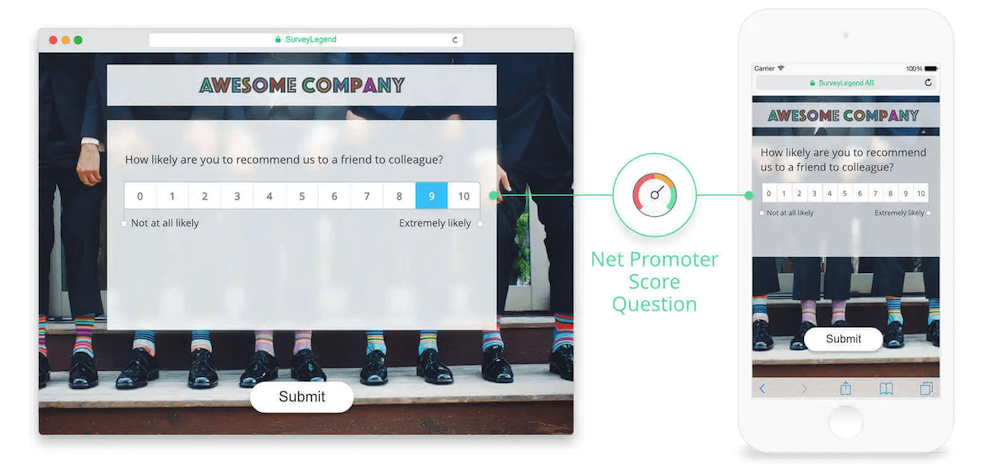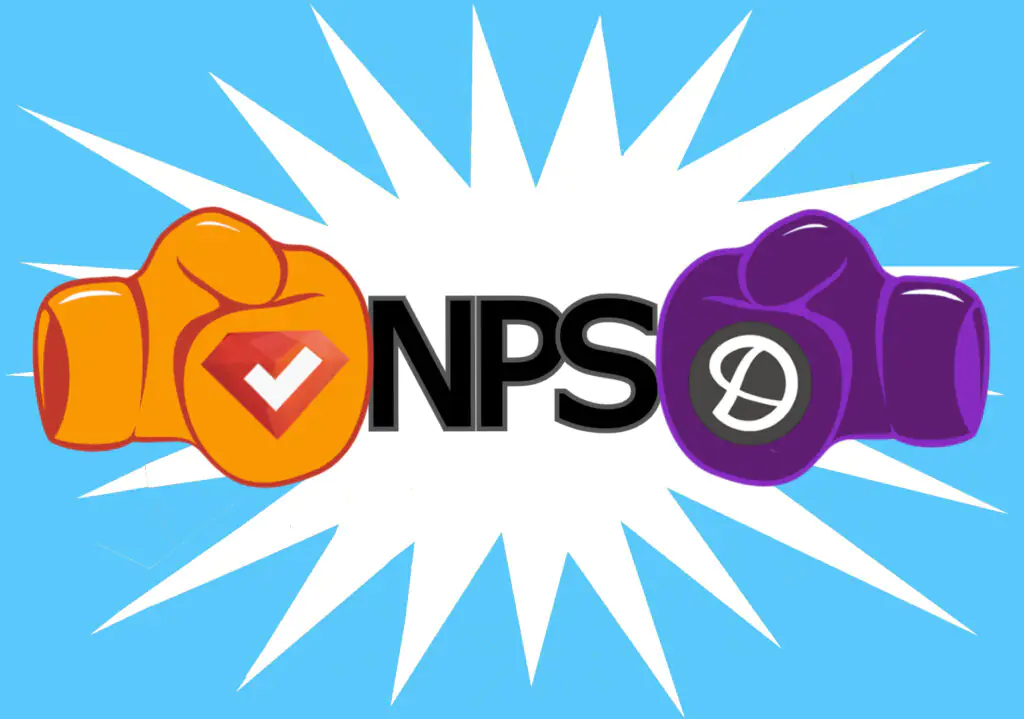Your Net Promoter Score, or NPS, lets you know exactly where you stand with your customers. Are they promoters, highly satisfied customers who wind up recruiting others through great word of mouth and positive reviews? Are they detractors, dissatisfied customers who may be actively discouraging others from trying your product or service through poor word of mouth and negative reviews? Or are they passives, those who don’t feel strongly one way or the other? Today, NPS has been widely adopted, with more than 75% of Fortune 1000 companies adopting the metric. So, what can we learn from them? Here are 15 NPS survey best practices!
What is a Net Promoter Score (NPS)?
Before we get into NPS survey best practices, here’s a quick refresher on NPS in general. A Net Promoter Score (NPS) is a customer loyalty score. It ranges from -100 to 100, and is calculated by asking customers how likely they would be to recommend your product or service to a friend or colleague, on a scale of one to ten. The resulting data can help you improve your products or services to increase the score. As a result, you can build customer loyalty and create enthusiastic brand advocates. Below, we’ve included an example of what an NPS Survey might look like. If you want to learn more, check out our blog What is an NPS Survey and Questions You Should Ask. Otherwise, on to the best practices!
15 NPS Survey Best Practices
Ready to see your NPS go through the roof? Here are 15 NPS best practices to help you get the best results from your NPS survey.
1. Get Complete Commitment
The first step in improving your NPS is to be sure that everyone in the organization understands the goal. Make your NPS goal a shared vision and get the entire team’s buy-in. Emphasizing the importance of improving NPS to improve the company and getting everyone on board will ultimately improve your bottom line!
2. Customize Your NPS Survey
Today, people are inundated with emails, increasing the likelihood that they’ll delete anything that seems like a standard form letter. So, customizing your NPS survey is crucial. Customizing your NPS survey could mean using the recipient’s name in the intro of the NPS email, highlighting the product they purchased in the subject line of an email (“What did you think about your new iPhone purchase?”), or adding your own branding to the survey (logos, colors, etc.).
3. Create Engaging NPS Survey Subject Lines
Assuming your survey is sent via email, you need to consider your subject line. The average office worker receives about 120 emails per day, so you need to stand out. If you know what product or service they’d purchased, include that in the subject line so they know that you know who they are. “Are you enjoying your new purse?” will certainly get more attention than “Let us know about your recent purchase.” Not getting many responses? One of the best practices in NPS survey design is to try A/B testing, which often involves sending out emails with different subject lines, content, or in-app color schemes or elements.
4. Understand Industry Benchmarks
Calculation of your NPS gives you a score from -100 (the worst) to 100 (the best). Too often, companies freak out if they don’t reach 100! While that is an admirable goal to strive for, very few companies ever get there; it would mean that no one surveyed has ever been dissatisfied with your product or service.
So, it helps to understand benchmarks for your industry and strive to simply surpass those (for example, department stores tend to do best, with an average of 58, while internet providers score lowest, with an industry average of just 2). Read more about common industry NPS scores and some specific company NPS scores here.
5. Pre-Notify Customers about Your NPS Survey
This is nothing more than a heads-up to customers. It could be a salesperson saying, “we’re going to ask you to complete a quick phone survey after this call” or an auto-generated email following a purchase stating “we’ll be sending you a satisfaction survey with receipt of your product, your response is appreciated!”. It may seem silly, but studies show that pre-notifying customers can improve response rates by up to nearly 30%!
6. Send NPS Surveys at the Right Time
It bears repeating: customers receive a lot of emails. If you’re emailing an NPS survey, sending it at the right time is critical. According to Smart Insights, ~24% of all emails are opened within the first hour of delivery, ~5% in the fourth hour, and less than 1% in the 24th hour. So, it’s important to reach out to customers when they’re most likely to answer within the hour. According to CoSchedule, that means sending your NPS survey on Tuesday, Wednesday, or Thursday at 10 am or 2 pm.
7. Survey Throughout the Buyers’ Journey
Customers typically have numerous touchpoints with your company and each should maintain the same standard of excellence. For example, a customer’s experience could be a 10 across the board, but then a shipping delay causes them frustration. Just this one touchpoint can greatly reduce your NPS score. By gaining internal commitment across the board, you can ensure that each step of the buyers’ journey is a smooth one.
8. Send NPS Surveys Regularly… But Don’t Send Them Too Often
It’s important to monitor NPS through surveys regularly; if you don’t, you’ll never know if you’re improving (or getting worse). Think about it: a customer who gave you a dismissive 2 might turn around and give you a promoter-level 9 after you’ve successfully addressed their concerns. Without regular NPS monitoring, you wouldn’t know that.
However, if you send an NPS questionnaire too often, you’ll be viewed as a nuisance. One of the worst things you can do is send a survey as soon as someone becomes a customer. NPS is designed to gauge the overall emotion someone has with your brand, good or bad, so asking them how they feel before they’re had much of an experience with your company is likely to turn them off, or skew results.
9. Use Responsive Survey Design
Today, there are countless varieties and sizes of mobile devices—and they all have different screen resolutions. That means if not properly formatted, your survey could render poorly on some screens, with images and words being cut off. One of the easiest ways to boost NPS survey response rates, then, is to make your survey responsive (i.e. mobile-friendly). Responsive design takes into consideration the different screen sizes and resolutions, shrinking or expanding content as necessary. And, with nearly 55% of web traffic coming from mobile users, this is more important than ever.
10. Send Follow-Up Questions NPS Survey Questions
It’s important to find out why a customer rated you one way or another. You’ll never know without follow-up questions. Keep that survey short and sweet, but make your questions count.
Promoters: Questions to ask following an NPS survey may include:
- What is the primary reason for your score?
- Tell us what did we do best during your experience?
- How can we do more to wow next time?
Passives: Questions to ask following an NPS survey may include:
- What is the primary reason for your score?
- Did you encounter any particular issues?
- What is one thing we could do better to meet your expectations?
Detractors: Questions to ask following an NPS survey may include:
- Why would you not recommend us?
- What could we have done to improve your experience?
- Would you consider us again if your suggestions were instituted?
11. Closely Monitor Your NPS
It’s important not to rest on laurels; just because you had a great score on your initial NPS survey, doesn’t mean it will stay that way. To be sure you’re not losing promoters or gaining detractors, you need to continuously monitor your NPS. If you see it dipping – or worse, taking a nose-dive – send follow-up questions asking what went wrong and what you can do better next time.
12. Share NPS Results with Your Team
If you’re monitoring your NPS result closely, the next best thing to do to improve NPS results is to share the NPS data with your team. This lets them know whether they should pat themselves on the back—or begin considering ways to improve. Sharing NPS results also gets everyone on the same page so that together, the company can work toward a common goal of customer satisfaction.
13. Respond to All NPS Surveys
If a customer takes the time to complete your NPS survey and/or follow-up questions, you can take the time to thank them by letting:
- Satisfied customers know that you appreciate their response and will continue to meet or exceed their expectations;
- Passives know you’ll do better in the future to keep them as a customer; and
- Detractors know you’ll work to resolve their issues (and then make good on that promise).
14. Reduce Response Time
If you’re good about responding to NPS surveys but your score isn’t improving, perhaps you need to respond faster. For example, if a customer emails you, they want to hear back soon asap. So, strive for one business day. And if they call you, they don’t want to enter an endless maze of automated messaging systems; they want to connect with a real person who can assist them right away. Make it easy for them!
15. Leverage Your Promoters
Your promoters are already out there telling others about how wonderful your product or service is. Nice! Good word-of-mouth marketing drives $6 trillion of annual consumer spending and is estimated to account for 13% of consumer sales. So imagine how much more good these promoters could be doing for your brand if they had an incentive to promote you? That’s where an affiliate program comes in. With an affiliate program, affiliates actively market your product or service, and they receive financial rewards when someone they referred becomes a customer. It’s a win-win for you and them! Read more about these programs here.
Conclusion
An NPS poll can help predict the future growth or decline of your company based on customers’ perceptions and attitudes toward your brand, and whether they will promote it—or bad-mouth it. To find out where you stand, start sending NPS surveys today!
You can view SurveyLegend’s Net Promoter Score template here, and if you use our services, we’ll also do all the NPS data calculations for you! On your Live Analytics page, you will be able to monitor your Net Promoter Score as it develops over time—and in real-time. Get started for free today!
For more, check out our Ultimate Guide to NPS and NPS Surveys.
Frequently Asked Questions (FAQs)
A Net Promoter Score (NPS) is a customer loyalty score ranging from -100 to 100.
An NPS survey is sent to customers in order to calculate NPS. It asks them how likely they would be to recommend your product or service to a friend or colleague, on a scale of one to ten.
NPS responses put customers into three categories: promoters (those likely to recommend your brand), passives (those who could “take it or leave it”), and detractors (those who would not recommend your brand or may actively discourage others from purchasing).
To get good NPS survey results, surveys should be customized, sent at the right time, sent regularly (but not too often), and include follow-up questions.





